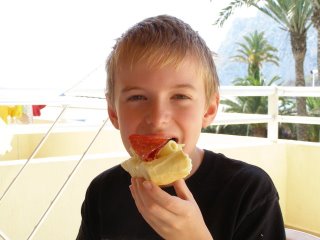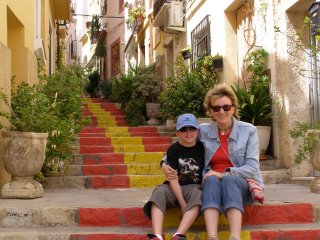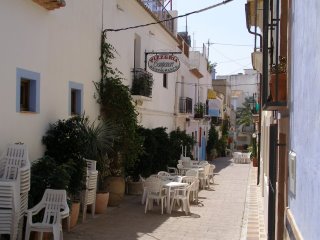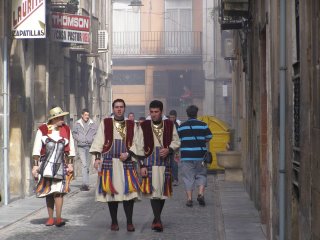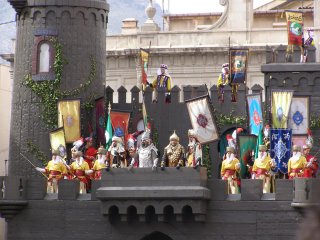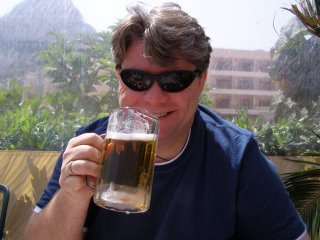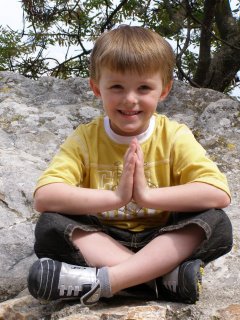Sunday, April 30, 2006
Saturday, April 29, 2006
Friday, April 28, 2006
Thursday, April 27, 2006
Wednesday, April 26, 2006
Tuesday, April 25, 2006
Monday, April 24, 2006
Sunday, April 23, 2006
Saturday, April 22, 2006
Friday, April 21, 2006
More from Iraq
A story from today's Guarniad seems to support yesterday's post re the horrors going on in Baghdad: -
Neighbourhood vigilantes first sprang up in Baghdad's middle- and upper-class suburbs in the looting and lawless chaos following Saddam Hussein's downfall. Residents mounted checkpoints to protect homes and shops. The new vigilantes are on guard to protect mosques and lives.
People, rather than buildings, became the next target. Hundreds of Baghdad Sunnis have been abducted and murdered in recent weeks, usually by armed men turning up at night, knocking on doors and seizing people. Sunnis wonder how the killers can so easily defy Baghdad's nightly curfew if they are not linked to the police.
Thursday, April 20, 2006
The Horror
I was chatting to one of my customers today and was shocked by the state of things in Baghdad. What started out as a chat about the wonders of Babylon, and ancient Iraq, soon moved on to current affairs. Ibrahim, who is of Iraqi birth moved to the UK some years ago, but still has family back in Baghdad.
He told me the shocking tale of a lady greengrocer in his mother's district of the city. One day, a friend of this ladies son approached her outside her shop, and asked a favour. He said that he was on his way to the Mosque to pray, and asked if she would mind looking after a bag of goods he had bought in the market until he returned. He said he had bought a sheep's head, to cook for dinner, and handed her the carrier bag. She of course agreed, as she knew the man well, and knew he was a friend of her son.
However, the day wore on, and there was no sign of the friend's return. As she had to close her stall and return home herself, she asked a neighbouring stall holder if he would look after the bag, until it was collected by the friend. He agreed, and out of curiosity opened the bag to take a peek. It was not a sheep's head, but the head of the woman's son.
I can't vouch for the veracity of the tale, but Ibrahim certainly presented it to me as truth, and I have no reason to doubt him. He also told me that events of similar horror were now commonplace in Iraq. Whilst acknowledging that Sadaam was a dictator, and had to be removed, he felt that the new government was little better, full of 'liars, cheats and robbers'.
What hope is there for a country such as this?
Sunday, April 16, 2006
Map Gallery of Religion in the United States

More on the religous breakdown of the USA at American Ethnic Geography . I have posted a map of the spread of my familial religious afilliation, The Congregationists, above. However, if you use this link , you can check on the spread of yours. thanks to http://www.boingboing.net/
More about Congregationists I hear you say? from wiki:-
Congregational churches are Protestant Christian churches practicing congregationalist church governance, in which each congregation independently and autonomously runs its own affairs.
Contents[hide]
1 Origins
2 United States
3 Later mergers with other groups
3.1 Australia
3.2 Canada
3.3 United Kingdom
3.4 United States
4 Notable Independents and Congregationalists
Origins
Many Congregational churches trace their descent from the original Congregational Church, a family of Protestant denominations formed on a theory of union published by the theologian Robert Browne in 1592 and arising from the Nonconformist religious movement in England during the Puritan reformation. In Great Britain, the early congregationalists were called separatists or independents to distinguish themselves from the similarly Calvinistic Presbyterians, and some congregationalists there still call themselves "Independents".
There are difficulties in identifying a specific beginning because Congregationalism is more easily identified as a movement than a single denomination, given its distinguishing commitment to the complete autonomy of the local congregation. The idea that each distinct congregation fully constitutes the visible Church can, however, be traced to John Wyclif and the Lollard movement which followed after Wyclif was removed from teaching authority in the Roman Catholic Church.
The early Congregationalists shared with Anabaptist theology the ideal of a pure church, which made adult conversion experience important for full membership in the church, unlike other Reformed churches. As such, the Congregationalists were a reciprocal influence on the Baptists, differing from them in that they counted the children of believers in some sense members of the church unlike the Baptists, because of baptism.
Saturday, April 15, 2006
White Light! White Light!
 Beware all Gremlins, scientists have at last invented a new way of producing lights. thanks to news.bbc.co.uk : -
Beware all Gremlins, scientists have at last invented a new way of producing lights. thanks to news.bbc.co.uk : -A light source that could put the traditional light bulb in the shade has been invented by US scientists.
The organic light-emitting diode (OLED) emits a brilliant white light when attached to an electricity supply.
The material, described in the journal Nature, can be printed in wafer thin sheets that could transform walls, ceilings or even furniture into lights.
The OLEDs do not heat up like today's light bulbs and so are far more energy efficient and should last longer.
They also produce a light that is more akin to natural daylight than traditional bulbs.
Friday, April 14, 2006
map of the Hickness of the USA
 speaks for itself, really...........
speaks for itself, really...........thanks to andrew sullivan via the consistantly interesting Harry's Place
link
Thursday, April 13, 2006
FCUK Exams?

Multiple choice:
Q: You are a student with impending exams. what do you do?
1. revise hard
2. plan, and then impliment the making of a giant 'fcuk' sign out of the windows of a campus tower block.
3. Procastrinate
I know that 3. is tempting, but some wags at the University of Waterloo, Ontario, prefered 2.
Or did they? read all about it at : studentlifecentre.com
hat tip BoingBoing
Wednesday, April 12, 2006
comment spam
Had my first comment spam today, so please excuse the word verification stuff if you want to make a comment. I'll see how this goes.
BTW, it read: -
Askinstoo said...
Very nice! I found a place where you canmake some nice extra cash secret shopping. Just go to the site below and put in your zip to see what's available in your area. I made over $900 last month having fun!
toads............
Tuesday, April 11, 2006
Ice Age poo

Went to see Ice Age 2, The Meltdown last weekend, & wish I hadn't.
Save yourselves the bother, wait until the dvd is out & buy it for the kids.
Monday, April 10, 2006
a touching story
Call me sentimental, but reading this after being on a firefighting and sea survival course last week touched me deeply: -
9/11 firefighters
In the days immediately following the terrorist attack on the World Trade Center, a 77-year-old man from Teaneck, New Jersey, tried repeatedly to cross the George Washington Bridge. He was turned away. But he tried again, and again, until finally police and military personnel waved him through, and soon enough, he was among those thousands who were putting their lives at risk in what proved to be a vain attempt to find and rescue survivors in the smoldering ruins of the Twin Towers
I feel proud to share the same drive to do the right thing as these guys, and I guess it goes someway to explain why so many firefighters are on our Lifeboat Crew.
(or perhaps its because we like beer.....)
Deutchland Uber Alles?
I was sent a bizzare training video the other day, so I'll share it here: -
FLT Training the German Way
YOU WILL ENJOY IT!
(takes a while to get going, have patience)
Sunday, April 09, 2006
Gone sailing
pssst.
wanna know what all these types of sailing vessels are?
look no further than wiki. (thanks)
Bark Barque Barquentine Bilander Brig Brigantine Caravel Carrack Catamaran Catboat Clipper Dutch Clipper Cog Corvette Cutter Dhow Fluyt Fore & Aft Rig Frigate Full Rigged Ship Gaff Rig Galleon Gunter Rig Hermaphrodite Brig Junk Ketch Mersey Flat Multihull Nao Norfolk Wherry Pink Pocket Cruiser Polacca Pram Proa Schooner Ship of the Line Sloop Smack Snow Square Rig Tall Ship Thames Sailing Barge Trimaran Wherry Windjammer Windsurfer Xebec Yacht Yawl
Tuesday, April 04, 2006
Beer , Beer, sing ho! for Beer!
My first day at the lifeboat college proved to be a boozy affair. I should have guessd what we were on for when we stopped for 'lunch' which consisted of wadworths 6x.
We got to Poole at about 4.30, & went to the pub. in fact, several pubs, pausing only to eat at the Lifeboat college at 7.00pm. Then, guess what? more beer. I retired tired & emotional at 10.00pm, to stock up on fluids, more fluids, and some fluids.
I then had a fitfull, empty night on my own
Sings : 'the bed's too big without you'....
I miss my kimmy.
Monday, April 03, 2006
Another view of the east/west troubles
Check out this video from The Middle East Media Research Institute (MEMRI). It gives a totally different view from the Middle East.
The Discovery of Slowness
Today, on the anniversary of the Battle of Copenhagen, it seems appropriate to review The Discovery of Slowness , by Sten Nadolny, Dave Algar's recommendation for the next El Grupo Libro's meet.
This little corker
 charts the amazing life of John Franklin, runaway, Midshipman, Veteran of the battles of Copenhagen and Trafalgar, Arctic Explorer, Governor of Tasmania, Knight of the British empire and finally, missing hero. However, the really extraordinary part of his life is that he managed all this with what the author calls ‘slowness’.
charts the amazing life of John Franklin, runaway, Midshipman, Veteran of the battles of Copenhagen and Trafalgar, Arctic Explorer, Governor of Tasmania, Knight of the British empire and finally, missing hero. However, the really extraordinary part of his life is that he managed all this with what the author calls ‘slowness’.From the beginning of his life, it became apparent that he was not like the other people. He could not catch a ball, or the ideas of people who spoke quickly. He was teased, and bullied repeatedly in each new situation until his peers began to notice his strengths. It seems that once he had committed something to memory, there it would stay, he could master detail that others could not, and was able to analyse problems and come to clear, usually correct, solutions. How he set about altering his life to cope with this difference, and to overcome obstacles forms the core of the book. I will leave it to you to discover his explanation for this part of his personality, and how he came to terms with it.
I thought that Nadolny spun a series of well-researched facts into an engaging novel. The early parts of Franklin’s life were fascinating and compelling. The middle part of the novel, and the end slowed down (no joke intended) for me, and left me wanting to know more. Maybe this part didn’t interest the author so much. I found that the writing was a bit two dimensional in places, with not much characterisation of the supporting ‘cast’, but I suppose that in a factual novel, many people drift in and out of importance during a lifetime, and perhaps there isn’t time for more detail. In a pure novel the author can concentrate on a small ‘cast’, so perhaps this isn’t fair. The translation may also have had a part in this clunkiness, and perhaps the book would read differently in the author’s native tongue. How the author discovered Franklin’s ‘slowness’ I am not sure, and how much of his descriptions are based in truth, but he paints an intriguing portrait of this trait.
In summary, I found the book a compelling read, looking at a fascinating time in our history from a very different perspective.
you can read more of the mystery of his final voyage here : - The Sir John Franklin Mystery
Sunday, April 02, 2006
Watch.......
The second series of Green Wing, C4, 9.00pm friday night,
followed by a little gem, My Name is Earl. Go on. watch it.
Green Wing Website
My Name is Earl
Global Maritime Distress Safety System
 I spent yesterday at the Inshore Lifeboat Station, ubdergoing a RYA certified Global Maritime Distress Safety System training course, similar to this one . At the end of the course, I was presented with my new GMDSS radio liscence.
I spent yesterday at the Inshore Lifeboat Station, ubdergoing a RYA certified Global Maritime Distress Safety System training course, similar to this one . At the end of the course, I was presented with my new GMDSS radio liscence. 10 - 4 for a copy, bring it on back, good buddy....
Next week, I shall be at the lifeboat college, on a First Aid, Firefighting, and Sea Survival course. what a busy, busy, boy.
Saturday, April 01, 2006
Mock turtle soup
I was chatting on Google chat the other day to the esteemed David Harcombe, of wired and wonderful when we happend upon Mock Turtle Soup. it sounds remarkably like a liquid version of Nick's headcheese . Minging!
From Wikipedia : -
Mock turtle soup is an English soup was created in the mid-18th century as a cheaper version of the more expensive Green turtle soup. It often uses brains and other organ meats to match the texture and flavor of the original.
Mrs. Fowle's Mock Turtle Soup, from Martha Lloyd's Household Book:
"Take a large calf's head. Scald off the hair. Boil it until the horn is tender, then cut it into slices about the size of your finger, with as little lean as possible. Have ready three pints of good mutton or veal broth, put in it half a pint of Madeira wine, half a teaspoonful of thyme, pepper, a large onion, and the peel of a lemon chop't very small. A 1/4 of a pint of oysters chop't very small, and their liquor; a little salt, the juice of two large onions, some sweet herbs, and the brains chop't. Stand all these together for about an hour, and send it up to the table with the forcemeat balls made small and the yolks of hard eggs."
Mock Turtle Soup is the basis for the Mock Turtle in Alice's Adventures in Wonderland, the joke being that Mock Turtle Soup is supposedly made from Mock Turtles.







